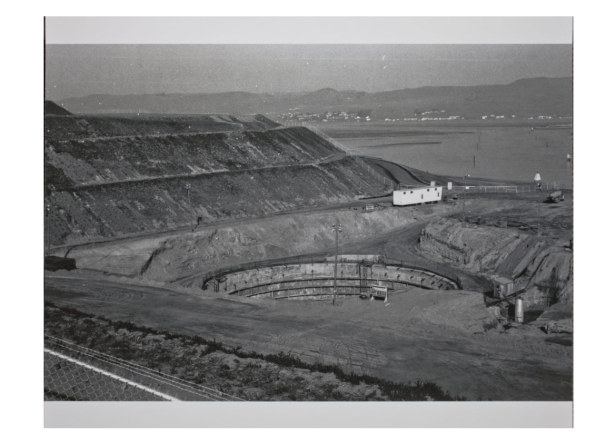 photo credit: Sonoma County Library Photography Collection
photo credit: Sonoma County Library Photography CollectionAtomic reactor pit at Bodega Head, California, 1964.
Sixty years ago this month commemorates the end of the battle between PG&E and Sonoma County residents opposed to a nuclear power plant on Bodega Head.
As Jacob Resneck reports, the struggle was fought between ordinary residents against powerful state and federal regulators and the investor-owned utility.
On a recent rainy Saturday about 40 people gathered on Bodega Head near an unnatural body of water excavated in the early 1960s by developers of an atomic power plant.
Sonoma State professor Matthew James brought some of the survivors together. He remarked the rainy downpour was similar to the day a scientist was snuck onto the property with a West County activist now in her 90s.
“Because that way, it's a reenactment of the events of 1964 when she came in here with a geologist and found the smoking gun,” James told the crowd.
That smoking gun was clear evidence that Bodega Head straddles the San Andreas Fault Line. The same fault responsible for the devastating 1906 earthquake whose epicenter was just south of here on Point Reyes.
“I was a Sonoma County housewife. I had four little kids … minding my own business… when I heard about a meeting in Santa Rosa, Nov. 10, 1963,” said Doris Sloan, the Sebastopol activist who says California residents were concerned as there were already documented cases of radiation from atomic testing in the Pacific.
“So the idea of a nuclear plant out here, never mind the fault that the plant releasing nuclear particles onto the West Sonoma and Marin dairylands, where the milk was going to San Francisco, this was not a popular idea,” Sloan said.
Historian Gaye LeBaron, who for years wrote for the Press Democrat, said PG&E had initially said it was interested in a conventionally powered steam plant when it eyed properties on the coastline.
But she says a Bodega Bay waitress named Hazel Mitchell overhead two utility workers confirm what many had suspected.
“Hazel overheard the two PG&E guys, ostensibly, this is the story, saying it was going to be an atomic plant, and she's the one who started, started it all,” LeBaron said.
By 1958 the company’s atomic plans were out in the open and it moved to condemn a local ranch to realize its plans of nuclear power on the Sonoma Coast.
Flash forward four years when an US government geologist named Pierre Saint-Amand heard a 1962 broadcast on Pacifica radio with energy regulators telling concerned Sonoma County residents to stop worrying about the atomic plant and leave it all to the experts.
He’s just returned from Chile where in 1960 the largest earthquake ever recorded devastated the region. He called the organizers and asked how he could help.
But Sloan says he had to be discreet as the Atomic Energy Commission was lead regulator.
“He couldn't do it officially, because all government employees had been told by the AEC to stay out of this. This was not not open for discussion,” Sloan said.
Saint-Amand arrived in Sonoma County and Sloan says she drove him to the site. It was a rainy day and there was no guard at the entrance.
“Nobody’s there… the gate's wide open. There's no construction because it's drizzling, and Pierre and I looked at each other, and he said, let's go,” Sloan recalled.
Within minutes he’d found evidence of an active fault line. When he returned to his job at the US Geological Service he requested aerial photos not mentioning that he’d ever been to Bodega Bay let alone trespassed on PG&E’s property.
“And they found the fault, and it wasn't very long until PG&E said the site is unsuitable,” Sloan said as the crowd applauded.
That story is only part of the activism during that more than half-decade when Sonoma County residents resisted atomic power on the coastline. There were stunts such as when hundreds of balloons were released on Memorial Day to show how prevailing winds could spread radioactive contamination.
And the 1963 album by Lu Watters Yerba Buena Jazz Band whose title track “Blues Over Bodega” became the clarion call for activists…
[Blues Over Bodega music]
Sixty years later ducks paddle around the freshwater that fills the crater excavated by utility crews. The site has come to be known as Hole in the Head. It’s a play on words combining the prominent Bodega Bay feature and the wisdom of locating a nuclear reactor atop an active fault line.
[Blues Over Bodega music]
Reporting for KRCB Sonoma County News, I’m Jacob Resneck in Bodega Bay

 Live Radio
Live Radio




